A Cleaner Delignification of Urban Leaf Waste Biomass for Bioethanol Production, Optimised by Experimental Design
Abstract
:1. Introduction
2. Materials and Methods
2.1. Raw Material Preparation
2.2. PoxAc Pretreatment
2.3. Biomass Proximal Composition
2.4. Confocal Laser Scanning Microscopy (CLSM)
2.5. Scanning Electron Microscopy (SEM)
3. Experimental Design
- (i)
- One includes designs used to explore a potentially large number of input variables to discover statistically significant ones and estimate their magnitude. Plackett–Burman (PBSD) and Factorial Fractional designs are examples of these methods [46].
- (ii)
- The other category includes methods for optimising a process given a reduced number of variables selected previously. A typical scenario is Central Composite (CC) or Box–Behnken Design (BBD) and an RSM analysis on linear or quadratic models. Moreover, RSM analysis allows fine-tuning of any process variables, an issue to be considered when an industrial scale is aimed [46]. The objectives of the RSM are to confirm observed or assumed effects in the variable selection stage and quantify the most appropriate values for the parameters under study to optimise the response. Finally, the predicted optimum must be verified after model building and optimisation.
Box–Behnken Design of Experiment
4. Results and Discussion
4.1. Effect of the Acid-Oxidative Hydrolysis on the LCW Characteristics
4.2. CLSM Autofluorescence Imaging
4.3. SEM Imaging
4.4. Pretreatment Performance Response Surface Regression
4.5. Impact of LCW Pretreatment Optimisation on Bioethanol Productivity
5. Conclusions
Author Contributions
Funding
Data Availability Statement
Conflicts of Interest
References
- Publications Office of the European Union. Masterplan for a Competitive Transformation of EU Energy-Intensive Industries Enabling a Climate-Neutral, Circular Economy by 2050. Available online: http://op.europa.eu/en/publication-detail/-/publication/be308ba7-14da-11ea-8c1f-01aa75ed71a1 (accessed on 21 September 2020).
- International Energy Agency. Renewables 2018: Analysis and Forecasts to 2023; International Energy Agency: Paris, France, 2018; ISBN 978-92-64-30684-4. [Google Scholar]
- Vargas, F.; Domínguez, E.; Vila, C.; Rodríguez, A.; Garrote, G. Agricultural Residue Valorization Using a Hydrothermal Process for Second Generation Bioethanol and Oligosaccharides Production. Bioresour. Technol. 2015, 191, 263–270. [Google Scholar] [CrossRef] [PubMed]
- Toor, M.; Kumar, S.S.; Malyan, S.K.; Bishnoi, N.R.; Mathimani, T.; Rajendran, K.; Pugazhendhi, A. An Overview on Bioethanol Production from Lignocellulosic Feedstocks. Chemosphere 2020, 242, 125080. [Google Scholar] [CrossRef] [PubMed]
- Gallone, B.; Mertens, S.; Gordon, J.L.; Maere, S.; Verstrepen, K.J.; Steensels, J. Origins, Evolution, Domestication and Diversity of Saccharomyces Beer Yeasts. Curr. Opin. Biotechnol. 2018, 49, 148–155. [Google Scholar] [CrossRef] [PubMed] [Green Version]
- Takada, M.; Chandra, R.; Wu, J.; Saddler, J.N. The Influence of Lignin on the Effectiveness of Using a Chemithermomechanical Pulping Based Process to Pretreat Softwood Chips and Pellets Prior to Enzymatic Hydrolysis. Bioresour. Technol. 2020, 302, 122895. [Google Scholar] [CrossRef]
- Pimentel, D. (Ed.) Biofuels, Solar and Wind as Renewable Energy Systems: Benefits and Risks; Springer: Dordrecht, The Netherlands, 2008; ISBN 978-1-4020-8653-3. [Google Scholar]
- McCaherty, J.; Wilson, C.; Cooper, G. 2019 Ethanol Industry Outlook; Renewable Fuels Association: Washington, DC, USA, 2019. [Google Scholar]
- Liu, C.-G.; Xiao, Y.; Xia, X.-X.; Zhao, X.-Q.; Peng, L.; Srinophakun, P.; Bai, F.-W. Cellulosic Ethanol Production: Progress, Challenges and Strategies for Solutions. Biotechnol. Adv. 2019, 37, 491–504. [Google Scholar] [CrossRef]
- Ahmed, I.N.; Yang, X.-L.; Dubale, A.A.; Shao, R.; Guan, R.-F.; Meng, X.; Xie, M.-H. Zirconium Based Metal-Organic Framework in-Situ Assisted Hydrothermal Pretreatment and Enzymatic Hydrolysis of Platanus X Acerifolia Exfoliating Bark for Bioethanol Production. Bioresour. Technol. 2019, 280, 213–221. [Google Scholar] [CrossRef]
- Alves-Ferreira, J.; Lourenço, A.; Morgado, F.; Duarte, L.C.; Roseiro, L.B.; Fernandes, M.C.; Pereira, H.; Carvalheiro, F. Delignification of Cistus Ladanifer Biomass by Organosolv and Alkali Processes. Energies 2021, 14, 1127. [Google Scholar] [CrossRef]
- Lee, C.S.; Conradie, A.V.; Lester, E. Review of Supercritical Water Gasification with Lignocellulosic Real Biomass as the Feedstocks: Process Parameters, Biomass Composition, Catalyst Development, Reactor Design and Its Challenges. Chem. Eng. J. 2021, 415, 128837. [Google Scholar] [CrossRef]
- López-Gómez, J.P.; Pérez-Rivero, C.; Venus, J. Valorisation of Solid Biowastes: The Lactic Acid Alternative. Process Biochem. 2020, 99, 222–235. [Google Scholar] [CrossRef]
- Vu, H.P.; Nguyen, L.N.; Vu, M.T.; Johir, M.A.H.; McLaughlan, R.; Nghiem, L.D. A Comprehensive Review on the Framework to Valorise Lignocellulosic Biomass as Biorefinery Feedstocks. Sci. Total Environ. 2020, 743, 140630. [Google Scholar] [CrossRef]
- Eades, P.; Kusch-Brandt, S.; Heaven, S.; Banks, C.J. Estimating the Generation of Garden Waste in England and the Differences between Rural and Urban Areas. Resources 2020, 9, 8. [Google Scholar] [CrossRef] [Green Version]
- Dessie, W.; Luo, X.; Tang, J.; Tang, W.; Wang, M.; Qin, Z.; Tan, Y. Towards Full Utilisation of Biomass Resources: A Case Study on Industrial Hemp Residue and Spent Mushroom Substrate. Processes 2021, 9, 1200. [Google Scholar] [CrossRef]
- Zhang, S.; Wang, Y.; Liu, S. Process Optimization for the Anaerobic Digestion of Poplar (Populus L.) Leaves. Bioengineered 2020, 11, 439–448. [Google Scholar] [CrossRef] [PubMed] [Green Version]
- Karimi, S.; Karimi, K. Efficient Ethanol Production from Kitchen and Garden Wastes and Biogas from the Residues. J. Clean. Prod. 2018, 187, 37–45. [Google Scholar] [CrossRef]
- Yu, Q.; Qin, L.; Liu, Y.; Sun, Y.; Xu, H.; Wang, Z.; Yuan, Z. In Situ Deep Eutectic Solvent Pretreatment to Improve Lignin Removal from Garden Wastes and Enhance Production of Bio-Methane and Microbial Lipids. Bioresour. Technol. 2019, 271, 210–217. [Google Scholar] [CrossRef]
- Ciudad Autonoma de Buenos Aires Planta de Residuos Forestales. Available online: https://www.buenosaires.gob.ar/ciudadverde/centro-de-reciclaje/planta-de-residuos-forestales (accessed on 1 March 2022).
- Mota, T.R.; Oliveira, D.M.; Morais, G.R.; Marchiosi, R.; Buckeridge, M.S.; Ferrarese-Filho, O.; dos Santos, W.D. Hydrogen Peroxide-Acetic Acid Pretreatment Increases the Saccharification and Enzyme Adsorption on Lignocellulose. Ind. Crops Prod. 2019, 140, 111657. [Google Scholar] [CrossRef]
- Hassan, S.S.; Williams, G.A.; Jaiswal, A.K. Emerging Technologies for the Pretreatment of Lignocellulosic Biomass. Bioresour. Technol. 2018, 262, 310–318. [Google Scholar] [CrossRef] [Green Version]
- Aditiya, H.B.; Mahlia, T.M.I.; Chong, W.T.; Nur, H.; Sebayang, A.H. Second Generation Bioethanol Production: A Critical Review. Renew. Sustain. Energy Rev. 2016, 66, 631–653. [Google Scholar] [CrossRef]
- Jimenez-Gutierrez, J.M.; Verlinden, R.A.J.; van der Meer, P.C.; van der Wielen, L.A.M.; Straathof, A.J.J. Liquid Hot Water Pretreatment of Lignocellulosic Biomass at Lab and Pilot Scale. Processes 2021, 9, 1518. [Google Scholar] [CrossRef]
- Sheng, Y.; Tan, X.; Gu, Y.; Zhou, X.; Tu, M.; Xu, Y. Effect of Ascorbic Acid Assisted Dilute Acid Pretreatment on Lignin Removal and Enzyme Digestibility of Agricultural Residues. Renew. Energy 2021, 163, 732–739. [Google Scholar] [CrossRef]
- Muaaz-Us-Salam, S.; Cleall, P.J.; Harbottle, M.J. Application of Enzymatic and Bacterial Biodelignification Systems for Enhanced Breakdown of Model Lignocellulosic Wastes. Sci. Total Environ. 2020, 728, 138741. [Google Scholar] [CrossRef] [PubMed]
- Jönsson, L.J.; Alriksson, B.; Nilvebrant, N.-O. Bioconversion of Lignocellulose: Inhibitors and Detoxification. Biotechnol. Biofuels 2013, 6, 16. [Google Scholar] [CrossRef] [PubMed] [Green Version]
- Song, Y.; Cho, E.J.; Park, C.S.; Oh, C.H.; Park, B.-J.; Bae, H.-J. A Strategy for Sequential Fermentation by Saccharomyces Cerevisiae and Pichia Stipitis in Bioethanol Production from Hardwoods. Renew. Energy 2019, 139, 1281–1289. [Google Scholar] [CrossRef]
- Wi, S.G.; Cho, E.J.; Lee, D.-S.; Lee, S.J.; Lee, Y.J.; Bae, H.-J. Lignocellulose Conversion for Biofuel: A New Pretreatment Greatly Improves Downstream Biocatalytic Hydrolysis of Various Lignocellulosic Materials. Biotechnol. Biofuels 2015, 8, 228. [Google Scholar] [CrossRef] [PubMed] [Green Version]
- Ghavami, N.; Özdenkçi, K.; Salierno, G.; Björklund-Sänkiaho, M.; De Blasio, C. Analysis of Operational Issues in Hydrothermal Liquefaction and Supercritical Water Gasification Processes: A Review. Biomass Convers. Biorefinery 2021. [Google Scholar] [CrossRef]
- Roman, J.; Neri, W.; Fierro, V.; Celzard, A.; Bentaleb, A.; Ly, I.; Zhong, J.; Derré, A.; Poulin, P. Lignin-Graphene Oxide Inks for 3D Printing of Graphitic Materials with Tunable Density. Nano Today 2020, 33, 100881. [Google Scholar] [CrossRef]
- Liu, C.; Li, M.; Mei, C.; Chen, W.; Han, J.; Yue, Y.; Ren, S.; French, A.D.; Aita, G.M.; Eggleston, G.; et al. Cellulose Nanofibers from Rapidly Microwave-Delignified Energy Cane Bagasse and Their Application in Drilling Fluids as Rheology and Filtration Modifiers. Ind. Crops Prod. 2020, 150, 112378. [Google Scholar] [CrossRef]
- Louis, A.C.F.; Venkatachalam, S. Energy Efficient Process for Valorization of Corn Cob as a Source for Nanocrystalline Cellulose and Hemicellulose Production. Int. J. Biol. Macromol. 2020, 163, 260–269. [Google Scholar] [CrossRef]
- Taşar, Ş.; Özer, A. A Comparative Study of Hemicellulose Isolation with Hot Water, Alkaline, and Delignification Methods from Tea Leaf Brewing Waste. Biomass Convers. Biorefinery 2020. [Google Scholar] [CrossRef]
- Technical Association of the Pulp and Paper Industry (TAPPI). Ash in Wood, Pulp, Paper and Paperboard: Combustion at 525 °C, Test Method T 211 Om-16. Available online: https://imisrise.tappi.org/TAPPI/Products/01/T/0104T211.aspx (accessed on 2 May 2022).
- Technical Association of the Pulp and Paper Industry (TAPPI). Solvent Extractives of Wood and Pulp, Test Method T 204 Cm-17. Available online: https://imisrise.tappi.org/TAPPI/Products/01/T/0104T204.aspx (accessed on 2 May 2022).
- Technical Association of the Pulp and Paper Industry (TAPPI). Acid-Insoluble Lignin in Wood and Pulp, Test Method T 222 Om-21. Available online: https://imisrise.tappi.org/TAPPI/Products/01/T/0104T222.aspx (accessed on 2 May 2022).
- Otalora, C.M.; Bonifazi, E.; Fissore, E.N.; Basanta, F.; Gerschenson, L.N. Thermal Stability of Betalains in By-Products of the Blanching and Cutting of Beta Vulgaris L. Var Conditiva. Pol. J. Food Nutr. Sci. 2020, 70, 15–24. [Google Scholar] [CrossRef]
- Hernández, Y.R.; García Serrano, L.A.; Maruri, D.T.; Jiménez Aparicio, A.R.; Camacho Díaz, B.H.; Arenas Ocampo, M.L. Optimization of the Microwave-Assisted Ethanosolv Extraction of Lignocellulosic Compounds from the Bagasse of Agave Angustifolia Haw Using the Response Methodology. J. Agric. Food Chem. 2018, 66, 3533–3540. [Google Scholar] [CrossRef] [PubMed]
- Novelli Poisson, G.F.; Juárez, Á.B.; Noseda, D.G.; Ríos de Molina, M.C.; Galvagno, M.A. Adaptive Evolution Strategy to Enhance the Performance of Scheffersomyces Stipitis for Industrial Cellulosic Ethanol Production. Ind. Biotechnol. 2020, 16, 281–289. [Google Scholar] [CrossRef]
- Hernández-Hernández, H.M.; Chanona-Pérez, J.J.; Terrés, E.; Vega, A.; Ligero, P.; Farrera-Rebollo, R.R.; Villanueva, S. Microscopy and Spectroscopy Tools for the Description of Delignification. Cellul. Chem. Technol. 2019, 53, 87–97. [Google Scholar] [CrossRef]
- Hernández-Hernández, H.M.; Chanona-Pérez, J.J.; Vega, A.; Ligero, P.; Mendoza-Pérez, J.A.; Calderón-Domínguez, G.; Terrés, E.; Farrera-Rebollo, R.R. Acetosolv Treatment of Fibers from Waste Agave Leaves: Influence of Process Variables and Microstructural Study. Ind. Crops Prod. 2016, 86, 163–172. [Google Scholar] [CrossRef]
- Hernández-Hernández, H.M.; Chanona-Pérez, J.J.; Calderón-Domínguez, G.; Perea-Flores, M.J.; Mendoza-Pérez, J.A.; Vega, A.; Ligero, P.; Palacios-González, E.; Farrera-Rebollo, R.R. Evaluation of Agave Fiber Delignification by Means of Microscopy Techniques and Image Analysis. Microsc. Microanal. 2014, 20, 1436–1446. [Google Scholar] [CrossRef]
- Savic, I.M.; Savic Gajic, I.M. Optimization Study on Extraction of Antioxidants from Plum Seeds (Prunus Domestica L.). Optim. Eng. 2021, 22, 141–158. [Google Scholar] [CrossRef]
- Mukherjee, A.; Banerjee, S.; Halder, G. Parametric Optimization of Delignification of Rice Straw through Central Composite Design Approach towards Application in Grafting. J. Adv. Res. 2018, 14, 11–23. [Google Scholar] [CrossRef]
- Montgomery, D.C. Design and Analysis of Experiments, 8th ed.; John Wiley & Sons, Inc.: Hoboken, NJ, USA, 2013; ISBN 978-1-118-14692-7. [Google Scholar]
- Song, Y.; Lee, Y.G.; Cho, E.J.; Bae, H.-J. Production of Xylose, Xylulose, Xylitol, and Bioethanol from Waste Bamboo Using Hydrogen Peroxide-Acetic Acid Pretreatment. Fuel 2020, 278, 118247. [Google Scholar] [CrossRef]
- Budiyono; Agustiani, V.; Khoiriyah, L.; Hawali Abdul Matin, H.; Rachmawati, S. Effect of Hydrogen Peroxide Acetic Acid Pretreatment on Kapok (Ceiba Pentandra) Fruit Peel Waste for Bioethanol Production Using Separated Hydrolysis and Fermentation Methods. Mater. Today Proc. 2022, in press. [Google Scholar] [CrossRef]
- Meng, F.; Li, N.; Yang, H.; Shi, Z.; Zhao, P.; Yang, J. Investigation of Hydrogen Peroxide-Acetic Acid Pretreatment to Enhance the Enzymatic Digestibility of Bamboo Residues. Bioresour. Technol. 2022, 344, 126162. [Google Scholar] [CrossRef]




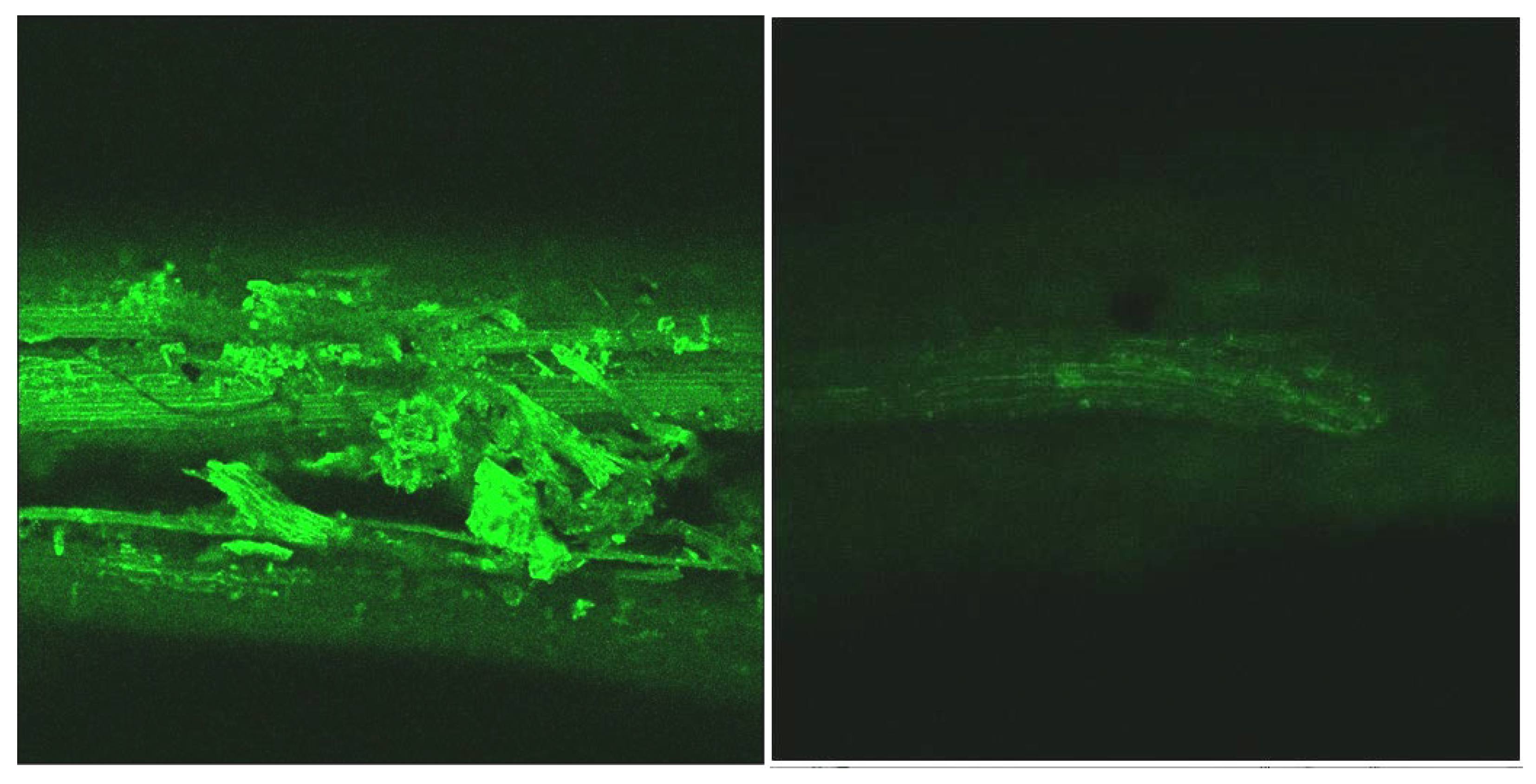

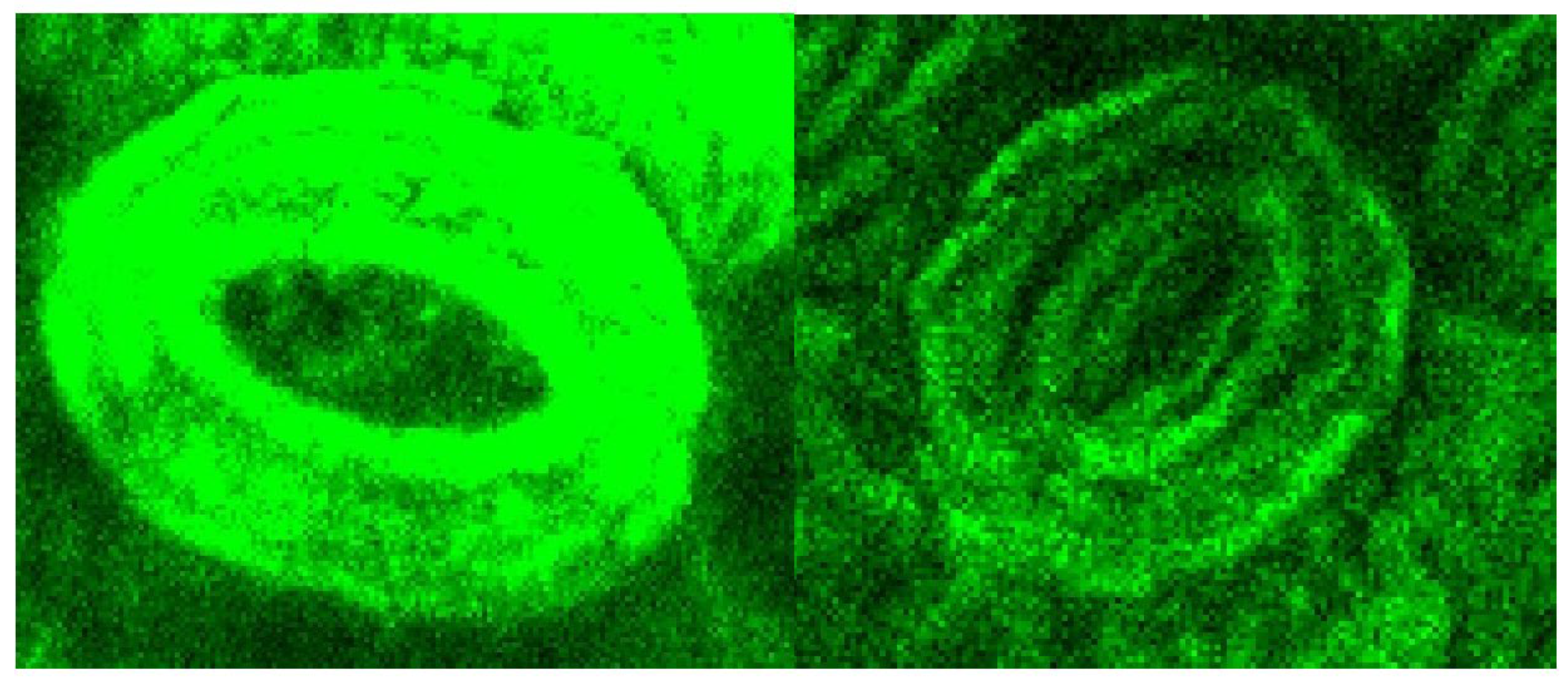
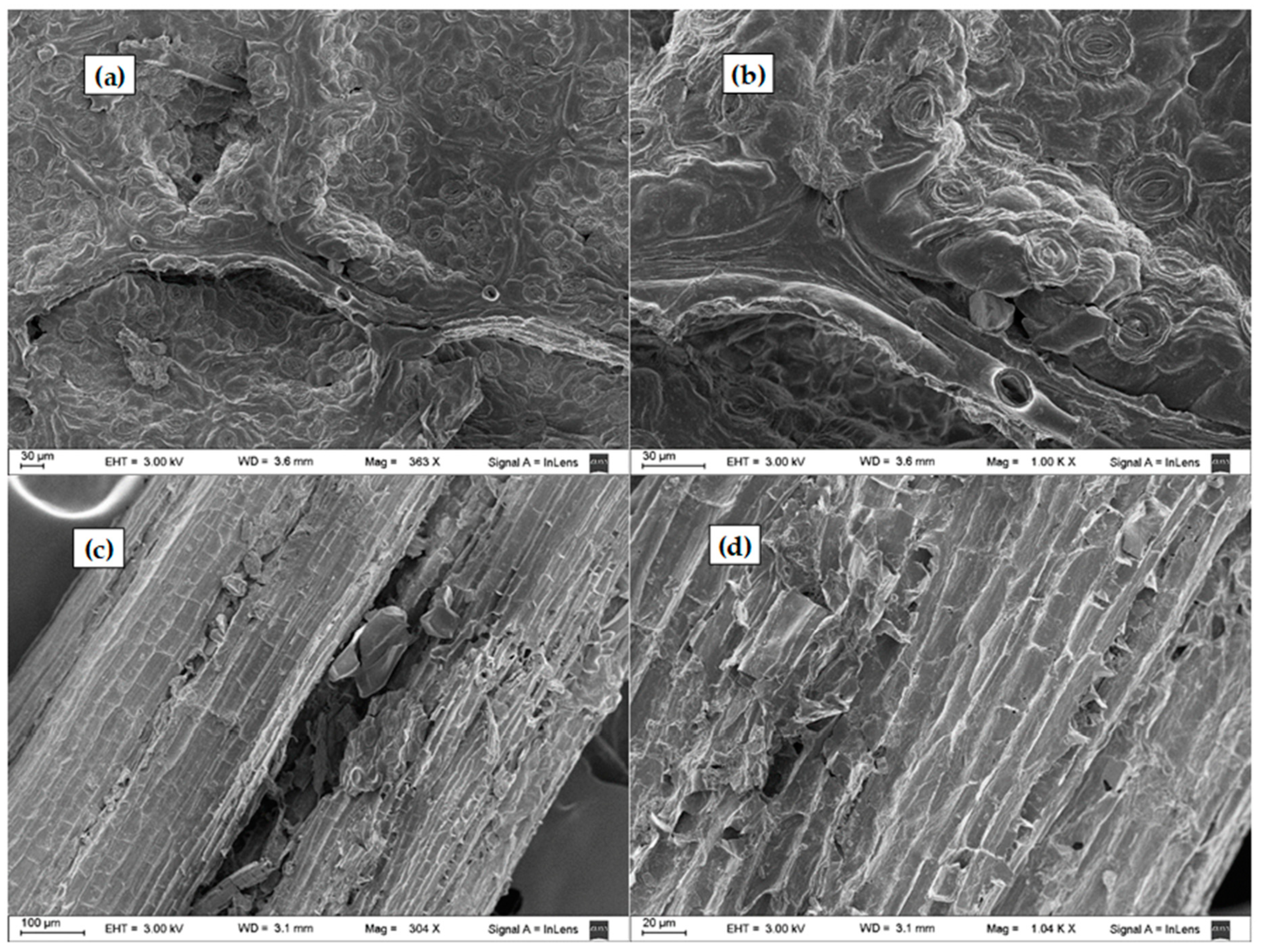
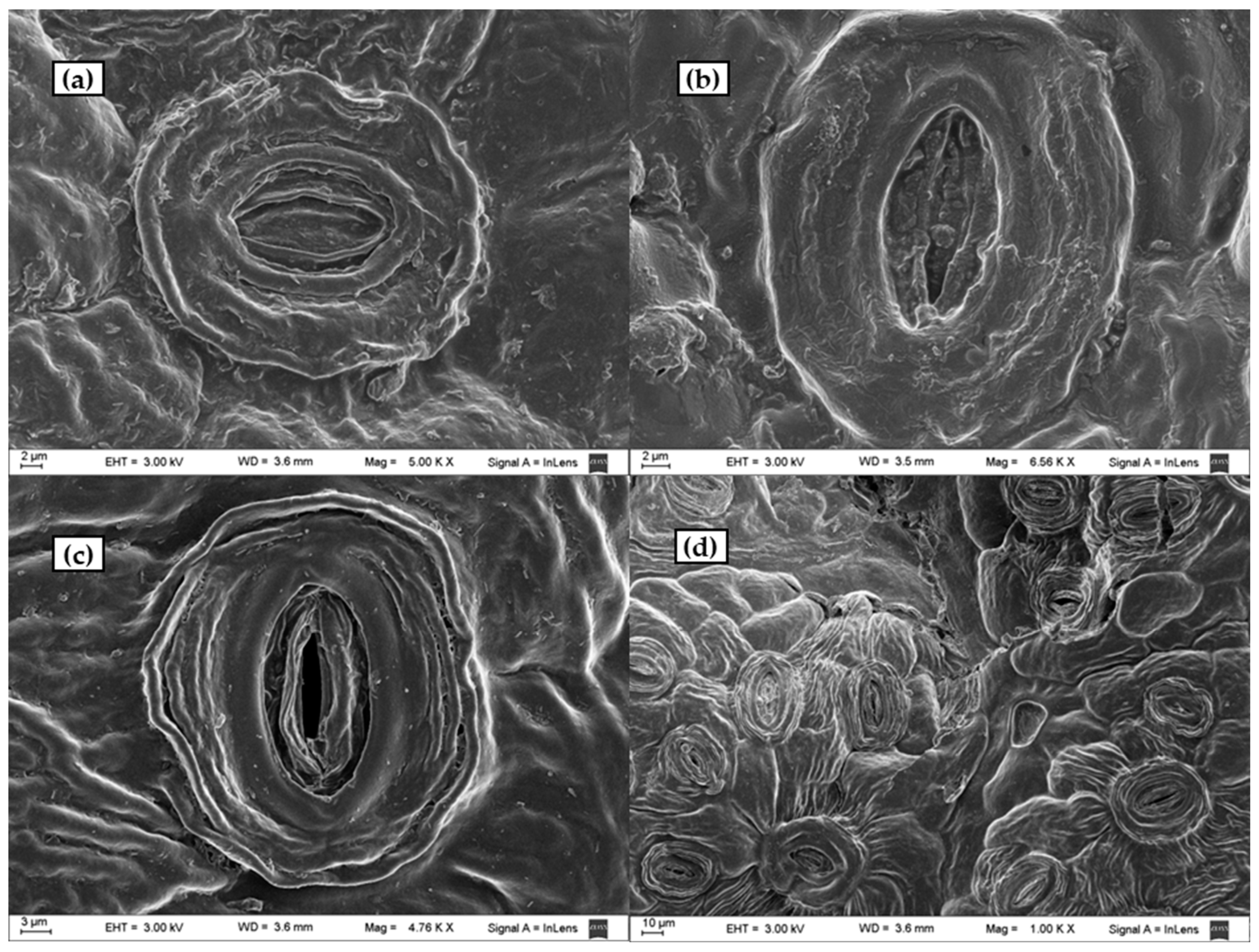

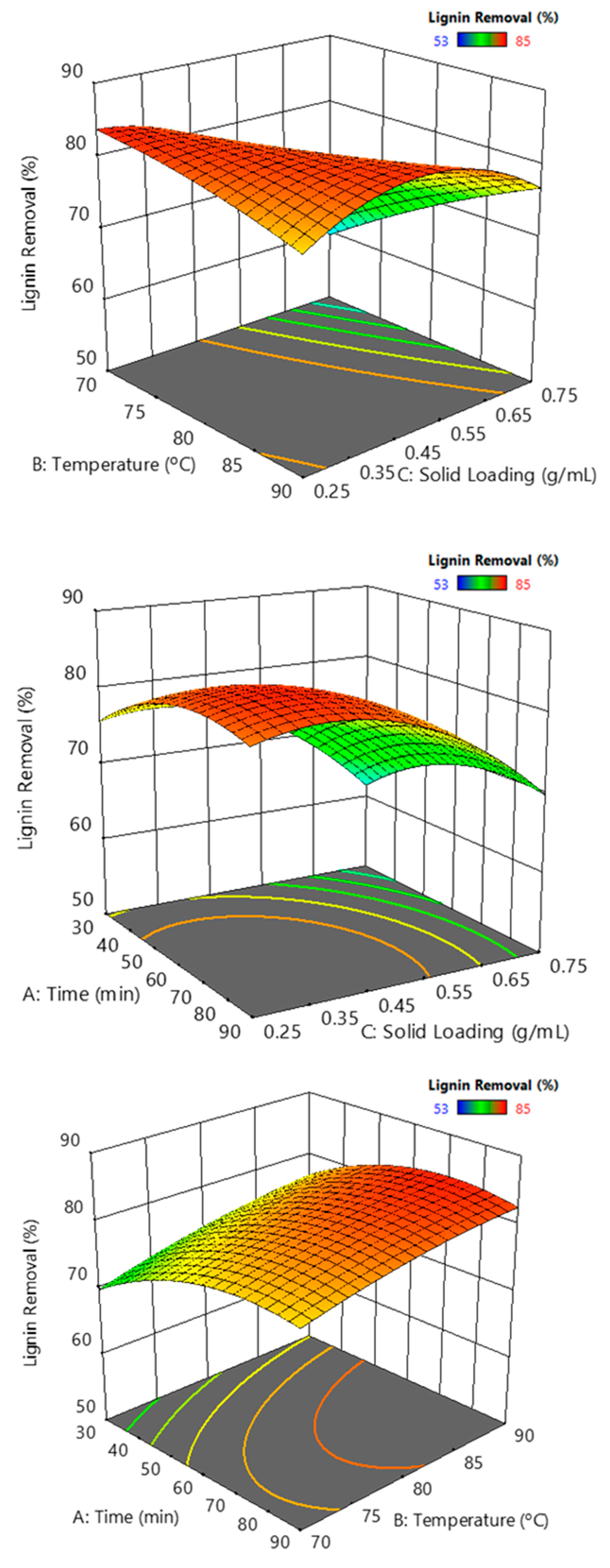
| Factors | Levels | ||
|---|---|---|---|
| −1 | 0 | 1 | |
| Time (min) | 30 | 60 | 90 |
| Temperature (°C) | 70 | 80 | 90 |
| Solid Loading (g/20 mL liquid) | 5 | 10 | 15 |
| Run | Time (min) | Temperature (°C) | Solid Loading (g/20 mL Liquid) | Log (Ro) |
|---|---|---|---|---|
| 1 | 90 | 80 | 15 | 1.37 |
| 2 | 30 | 80 | 15 | 0.89 |
| 3 | 90 | 70 | 10 | 1.07 |
| 4 | 60 | 90 | 5 | 1.48 |
| 5 | 90 | 80 | 5 | 1.37 |
| 6 | 60 | 70 | 15 | 0.89 |
| 7 | 90 | 90 | 10 | 1.66 |
| 8 | 60 | 80 | 10 | 1.19 |
| 9 | 60 | 80 | 10 | 1.19 |
| 10 | 30 | 70 | 10 | 0.59 |
| 11 | 60 | 70 | 5 | 0.89 |
| 12 | 30 | 80 | 5 | 0.89 |
| 13 | 30 | 90 | 10 | 1.18 |
| 14 | 60 | 90 | 15 | 1.48 |
| 15 | 60 | 80 | 10 | 1.19 |
| S1 | 90 | 90 | 5 | 1.66 |
| E1 | 60 | 60 | 5 | 0.60 |
| Sample | Log (Ro) | % Lignin | Fluorescence Intensity |
|---|---|---|---|
| Untreated | - | 40% | ++++ |
| Run #6 | 0.89 | 28% | ++ |
| Run #4 | 1.48 | 14% | + |
| Run S1 | 1.66 | 45% | +++ |
| Response Surface Regression | |||||
|---|---|---|---|---|---|
| SF Yield (%) vs. Time (min), Temperature (°C) and Solid Loading (g/mL) | |||||
| Analysis of Variance | |||||
| Source | DF | Adj SS | Adj MS | F-Value | p-Value |
| Model | 9 | 0.0795 | 0.0088 | 3.46 | 0.092 |
| Linear | 3 | 0.0619 | 0.0206 | 8.09 | 0.023–S |
| Time (min) | 1 | 0.0075 | 0.0075 | 2.95 | 0.146 |
| Temperature (°C) | 1 | 0.0199 | 0.0199 | 7.79 | 0.038–S |
| Solid loading (g/mL) | 1 | 0.0345 | 0.0345 | 13.52 | 0.014–S |
| Square | 3 | 0.0127 | 0.0042 | 1.66 | 0.289 |
| Time (min) × Time (min) | 1 | 0.0042 | 0.0042 | 1.66 | 0.253 |
| Temperature (°C) × Temperature (°C) | 1 | 0.0001 | 0.0001 | 0.06 | 0.820 |
| Solid load (g/mL) × Solid load (g/mL) | 1 | 0.0088 | 0.0088 | 3.44 | 0.123 |
| 2-Way Interaction | 3 | 0.0049 | 0.0016 | 0.64 | 0.619 |
| Time (min) × Temperature (°C) | 1 | 0.00023 | 0.00023 | 0.09 | 0.777 |
| Time (min) × Solid loading (g/mL) | 1 | 0.00004 | 0.00004 | 0.01 | 0.911 |
| Temperature (°C) × Solid load (g/mL) | 1 | 0.00467 | 0.00467 | 1.83 | 0.234 |
| Error | 5 | 0.01276 | 0.00255 | ||
| Lack-of-Fit | 3 | 0.00662 | 0.00220 | 0.72 | 0.627 |
| Pure Error | 2 | 0.006140 | 0.003070 | ||
| Total | 14 | 0.092289 | |||
| Model Summary: S = 0.0505086 R-sq = 86.18% | |||||
Publisher’s Note: MDPI stays neutral with regard to jurisdictional claims in published maps and institutional affiliations. |
© 2022 by the authors. Licensee MDPI, Basel, Switzerland. This article is an open access article distributed under the terms and conditions of the Creative Commons Attribution (CC BY) license (https://creativecommons.org/licenses/by/4.0/).
Share and Cite
Kildegaard, G.; Balbi, M.d.P.; Salierno, G.; Cassanello, M.; De Blasio, C.; Galvagno, M. A Cleaner Delignification of Urban Leaf Waste Biomass for Bioethanol Production, Optimised by Experimental Design. Processes 2022, 10, 943. https://doi.org/10.3390/pr10050943
Kildegaard G, Balbi MdP, Salierno G, Cassanello M, De Blasio C, Galvagno M. A Cleaner Delignification of Urban Leaf Waste Biomass for Bioethanol Production, Optimised by Experimental Design. Processes. 2022; 10(5):943. https://doi.org/10.3390/pr10050943
Chicago/Turabian StyleKildegaard, Gustavo, María del Pilar Balbi, Gabriel Salierno, Miryan Cassanello, Cataldo De Blasio, and Miguel Galvagno. 2022. "A Cleaner Delignification of Urban Leaf Waste Biomass for Bioethanol Production, Optimised by Experimental Design" Processes 10, no. 5: 943. https://doi.org/10.3390/pr10050943








